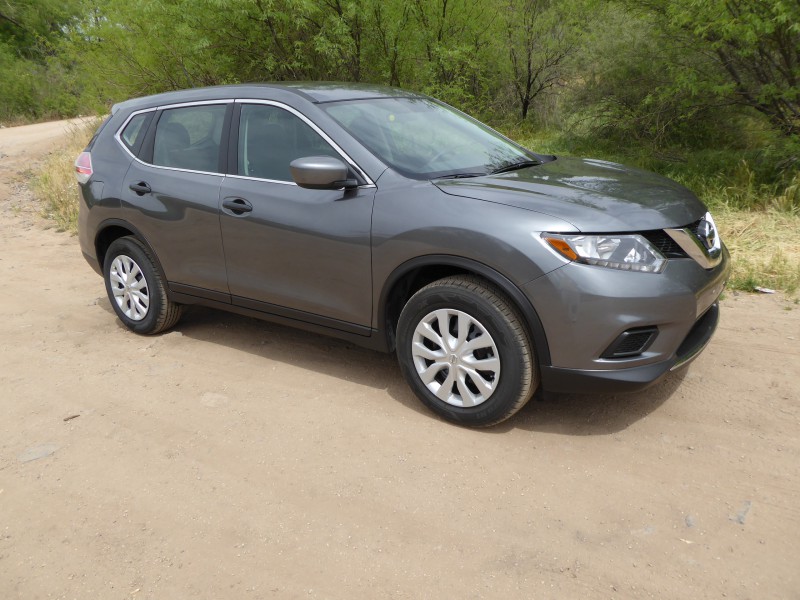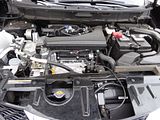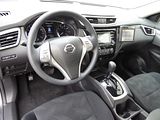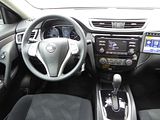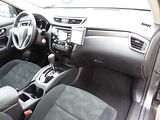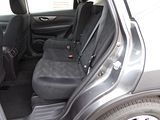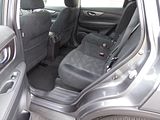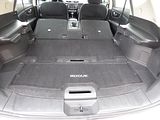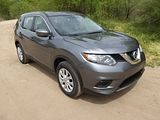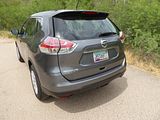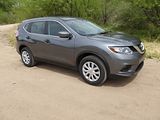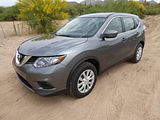
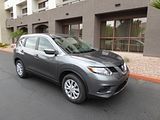
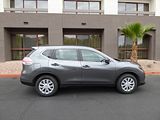
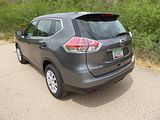
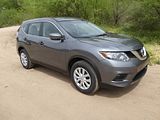
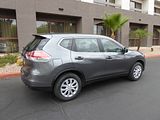

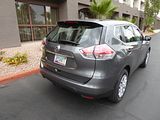
Whilst the XTrail and the Rogue look the same, mechanically there are differences, especially in terms of the choice of engine. European spec models are most commonly seen with either the familiar 1.6 or 2 litre DCi diesel engine under the bonnet, which also see service in a variety of other Nissan and Renault models, though a petrol engine is available, in the guise of a 2 litre 143 bhp unit. Customers can choose between manual or CVT automatic gearboxes, For the US, there is no diesel option. All Rogues currently come with a 2.5 litre 4 cylinder petrol engine, coupled to Nissan’s X-Tronic continuously variable automatic gearbox. That means that the customer only has to choose between one of three trim levels and whether to go for front wheel or all wheel drive. The test car was an entry level S model, with front wheel drive. The 2.5 litre unit develops 170 bhp and 175 lb/ft of torque, which is right in the middle of the pack among the model’s competitors, though many of them do have a more powerful unit available as well, something which the Rogue does not offer. My notes use the word “smooth” more than once in describing the driving sensation. So whilst there only be four cylinders under the bonnet, Nissan’s engineers have done a good job on delivering a refined powerplant that will get the job done without fuss. The Rogue is not fast, and output numbers like that would not lead you to expect that it would be, but nor does it feel under-endowed. CVT gearboxes do not always deliver on the promise of a car being in the optimum gear ratio at any given time, but in this case, the result is pretty much just that. Acceleration levels are decent enough, and at least whilst you are gaining speed, the transmission keeps up well with what your right foot is doing, and this one was smoother than many when you were braking, too. With some rather poor weather and a flight in the early evening, I did not drive this test car as far as many that I have for a 24 hour period when in the Phoenix area, so the test mileage comprised a short journey out of town to a photo location and some local pottering about. The out of town route included some steady but fairly significant inclines, which are a tougher test for some cars than you think they are going to be, but the Rogue acquitted itself well, with the car maintaining momentum, and without your ears being in doubt as to how hard it was having to work to achieve it. And nor was there any penalty at the fuel pump, with the Nissan needing very little fuel to brim the tank., The calculator translated that into 30.0 mpg US, which equates to 35.84 mpg Imperial, a decent result, and other test reports suggest that this car is indeed among the most economical of its rivals, though this number is some way short of what I achieved with an Altima sedan powered by the same engine. The rest of the driving characteristics proved utterly unremarkable. There is nothing to criticise as being a weakness, or something that you could not live with, but equally, there is nothing that really stands out. The steering is light, but retains more feel than you find in a RAV4, the handling is exactly what you expect, tending to understeer, but in an utterly predictable way, with modest levels of roll as you tackle the bends with more enthusiasm. There is a Sport button on the lower left of the dash, but pressing it did not seem to change very much, and for that matter nor did selecting the Eco setting which is also offered. The ride, on relatively high profile 225/65 R17 tyres, proved smooth and comfortable, though, as has been noted many times before, the roads of Arizona are far less of a stern test than those in neighbouring California. Noise levels are low, with engine, tyres and wind well suppressed, so this would be a comfortable machine for a longish drive out. The brakes were well-judged with good feel to the pedal, and no issues with the stopping performance that I could discern. There is a foot-operated parking brake. You can see out of this model about as well as you can any modern Crossover. A rear-view camera is now fitted, which helps in judging where the back of the Rogue is, but it was easier to assess even without this aid anyway, given the relatively vertical rear end of the vehicle. Certainly, the Rogue is easy to place on the road and to manoeuvre, something that its owners would doubtless appreciate.
Inside the cabin, you would know that this was a Nissan even without the benefit of the badge in the middle of the steering wheel boss, as the car uses the current family style and has many of the individual switches, stalks and other components that you will find in other models in the range. Everything fits together particularly well, and it all feels durable, but there is a lot of black hard plastic and in the S level trim, the steering wheel is a plastic moulded item. No amount of gloss piano black inlays, and gunmetal (plastic) surrounds to the air vents and steering wheel spokes, both of which do feature, can really lift the cabin to make it look exciting or, for that matter, particularly premium, though the design itself is neat and refreshingly unfussy. The dash moulding itself is slightly swooping across the car, overall with a curved and raised binnacle covering the instruments. There are two large dials, for speedometer and rev counter, with smaller ones for fuel level and water temperature inset. They are clearly marked and easy to read. Between them is a digital display area, and you can cycle through the various data points by pressing small buttons on the left hand spoke of the steering wheel. Twin column stalks operate the indicators and lights on the left hand one, and wipers on the right. The middle of the dash incorporates the infotainment display screen. In this entry level S model, this is a relatively basic radio unit, though it does include XM Satellite radio, Bluetooth, integration with your smartphone and there is a rear-view camera. There are old-style buttons and knobs to operate the radio, with repeaters on the steering wheel hub where you will also find the cruise control, and many will agree that these may well be preferable to the move to touch screen operation for almost everything. Beneath the radio unit are the buttons and two dials for the air conditioning system. The whole set up is relatively simple and unfussy compared to some rival offerings (such as the Ford Escape), and in many ways all the better for that. Navigation is only available on more luxurious Rogue models, though the test car did feature a Hertz Never Lost unit to fill that gap in available functionality.
Seats of the test car were trimmed with a sort of velvet like material as opposed to the sort of cheap cloth that you get in American or European models at this price point. There is manual adjustment of the seat, including height, though I find it was surprisingly high even at the lowest point of its adjustable range. The seat felt quite well stuffed, but that did not make the perch seem uncomfortable, at least for the time I spent sitting on it. The steering column had a telescoping in/out as well as up/down to it, so the driving position I could find was good. There is plenty of room for those in the back seats. Even with the front seats set well back, legroom will suffice, and there is not much of a central tunnel to get in the way of the legs of a middle seat occupant. The seats are on sliders, so you can vary the amount of space you give occupants here relative to luggage area by a total of 9″, and the 40/20/40 split backrests can be reclined somewhat as well. Clearly the Crossover styling means that headroom is plentiful, too. There’s a good sized boot, too, one of the largest in its class. It has a false floor in it, which Nissan call “Divide-N-Hide”. There are two separate fibre boards which are part of the load area floor and if in place mean that the load area is flush with the bottom of the opening aperture. Like this, there is good deep stowage space underneath, and this is probably a more practical and preferable set-up compared to one with nets and small oddments wells that you find in rival products. Even with this arrangement in place, the main load area is deep enough before you reach the window line, and is a nice regular shape, with the width extending right across the car, and decently long from front to back. More space can be created by dropping the asymmetrically split rear seat backrests, and with both folded, there is a sizeable cargo area, though.it is not completely flat as the backrests just rest on the rear seat cushion and slope upward a bit. You can also fold the front passenger seat flat, for even more length. There are, apparently, 18 different combinations of load space configuration using the Divide-N-Hide system. Roof rails are an option, though these did not feature on the test car. Nissan do offer a 7 seat option on the Rogue, something that most of its competitors don’t offer. Although the test car was the 5 seater you could see that any third row would be very tight and that it would deprive you of almost all the boot space with the seats erect. There is plenty of space for odds and ends in the passenger cabin, as is generally the case with Nissan products. The glovebox is massive, and there is a split level cubby in front of the gear lever, as well as an area under the armrest, and modest door bins. Rear seat occupants get bins on the doors and map pockets on the back of the front seats.
There are three trim levels for the Rogue: S, SV and SL. They have changed little since the introduction of the second generation for the 2014 model year, though the XM Satellite radio was standardised for 2015 and for 2016 the option of emergency forward braking was added. The test car was the entry level S, and many will consider that this version lacks a few of the features that they would want. You can spot one from its lack of alloy wheels, and there is no trim badging on the tailgate. Inside there is a plastic steering wheel, but you do get an infotainment centre that integrates with your smartphone, displaying select apps on a 5-inch display. a USB port, XM Satellite radio, a rear-view camera, Bluetooth, hands-free text messaging capabilities, and a four-speaker sound system as well as air conditioning, cruise control, split rear seats with sliders and reclining backrests. You can add the third-row seat, as part of the $1,190 S Family Package, which adds privacy glass and run-flat tyres but removes the full Divide-N-Hide cargo system. The Rogue SV adds safety tech such as blind spot monitoring and rear cross traffic alert, as well as a leather-wrapped steering wheel, heated front seats, a six-way power-adjustable driver’s seat with power lumbar support, dual-zone automatic climate control, a proximity key, and push-button start. Outside, the SV adds heated mirrors, roof rails, and remote engine start. Its 17-inch wheels are alloy instead of the standard steel wheels. Here you can also add a third-row seat as part of the SV Family Package for $940, and you can opt into the larger 7-inch touch screen. The SL trim is the most luxurious Rogue available, but it only comes as a 2-row, five-seat SUV. Highlights include a hands-free tailgate, leather upholstery, a heated steering wheel, a 360-degree camera, automatic high beams, memory settings for the driver’s seat, and 18-inch alloy wheels. The SL also adds the larger, upgraded infotainment system. Adaptive cruise control, lane departure warning, lane keep assist, and the addition of pedestrian detection with forward emergency braking are available as part of the Platinum Package for $770. However, this package also requires you to select the $2,020 Premium Package, which includes a panoramic moonroof, forward emergency braking, 19-inch alloys, and LED headlights.
The test car was finished in what is called Gun Metallic, which is basically Grey to you and I. Sadly, I have to conclude that the colour rather suited the Rogue, as it felt it bit like a “grey” car. It was perfectly competent, with no significant weaknesses, but it also seemed somewhat devoid of character, or personality. For many people, who want a practical small SUV, that will be just about perfect, of course, as this is just what they are looking for. I can certainly think of no good reason to take a Toyota RAV4 in preference to the Rogue, unless the deal was so financially compelling and you really don’t care about the car, and what it is like to look at or to drive (or you want the Hybrid version that Toyota offer). The US press have generally rated the Honda CR-V and the Subaru Forester as their class picks. I’ve not driven either, but the Honda has also been to the Department of the Ugly Stick, so would struggle on those grounds alone. This is a competitive class, though, with a new duo from Korea recently released, and the Hyundai Tucson, the first of the pair to market has been absolutely flying out of the showroom in many countries around the world. The Kia is similar enough, just clothed in a different body. Both are well worthy of consideration, but although I’ve yet to sample it, despite trying quite hard for three years since its release, I think my choice from this class would be the Mazda CX-5, which seems to have good looks, a nice interior and class leading driving dynamics all in its favour. It looks like the one to beat.

